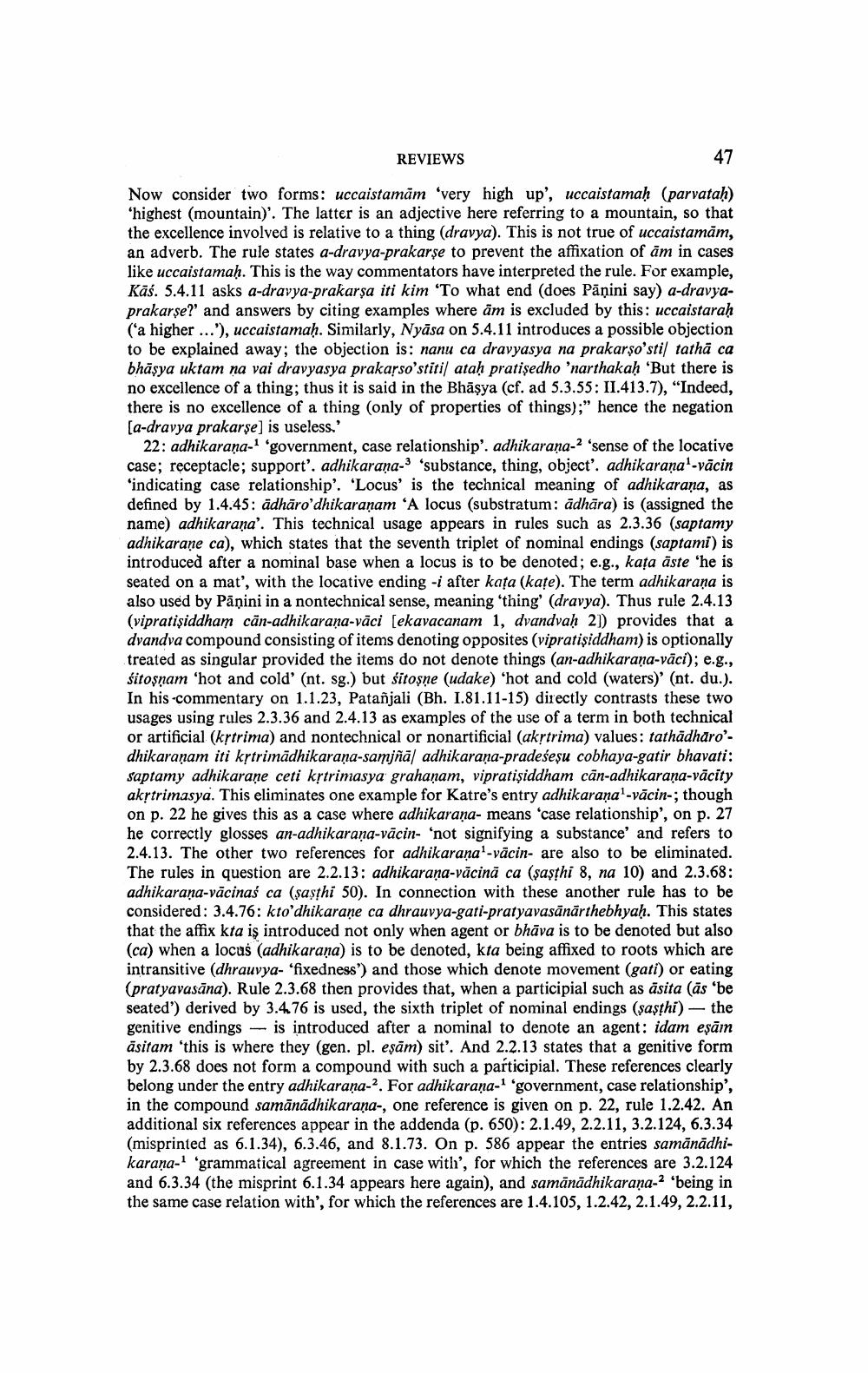Book Title: Reviews Of Different Books Author(s): Publisher: View full book textPage 5
________________ REVIEWS 47 Now consider two forms: ucсaistamām 'very high up', ucсaistamaḥ (parvatah) "highest (mountain)'. The latter is an adjective here referring to a mountain, so that the excellence involved is relative to a thing (dravya). This is not true of ucсaistamām, an adverb. The rule states a-dravya-prakarse to prevent the affixation of am in cases like ucсaistamaḥ. This is the way commentators have interpreted the rule. For example, Kas. 5.4.11 asks a-dravya-prakarsa iti kim 'To what end (does Panini say) a-dravyaprakarse?' and answers by citing examples where am is excluded by this: ucсaistaraḥ (a higher ...'), ucсaistamaḥ. Similarly, Nyasa on 5.4.11 introduces a possible objection to be explained away; the objection is: nanu ca dravyasya na prakarso'stitatha ca bhasya uktam na vai dravyasya prakarso'stiti/ atah pratisedho 'narthakah 'But there is no excellence of a thing; thus it is said in the Bhasya (cf. ad 5.3.55: 11.413.7), "Indeed, there is no excellence of a thing (only of properties of things);" hence the negation (a-dravya prakarse) is useless.' 22: adhikarana-1 'government, case relationship'. adhikarana-2 'sense of the locative case; receptacle; support'. adhikarana-3 'substance, thing, object'. adhikarana-vacin 'indicating case relationship'. 'Locus' is the technical meaning of adhikarana, as defined by 1.4.45: adharo'dhikaranam 'A locus (substratum: adhara) is assigned the name) adhikarana'. This technical usage appears in rules such as 2.3.36 (saptamy adhikarane ca), which states that the seventh triplet of nominal endings (saptami) is introduced after a nominal base when a locus is to be denoted; e.g., kata aste 'he is seated on a mat', with the locative ending -i after kata (kate). The term adhikarana is also used by Panini in a nontechnical sense, meaning 'thing' (dravya). Thus rule 2.4.13 (vipratisiddham can-adhikarana-vaci (ekavacanam 1, dvandvah 2]) provides that a dvandva compound consisting of items denoting opposites (vipratisiddham) is optionally treated as singular provided the items do not denote things (an-adhikarana-vaci); e.g., sitosnam 'hot and cold' (nt. sg.) but sitosne (udake) 'hot and cold (waters)' (nt. du.). In his -commentary on 1.1.23, Patanjali (Bh. I.81.11-15) directly contrasts these two usages using rules 2.3.36 and 2.4.13 as examples of the use of a term in both technical or artificial (krtrima) and nontechnical or nonartificial (akrtrima) values: tathadharo'dhikaranam iti krtrimadhikarana-samjnal adhikarana-pradesesu cobhaya-gatir bhavati: saptamy adhikarane ceti krtrimasya grahanam, vipratisiddham can-adhikarana-vacity akstrimasya. This eliminates one example for Katre's entry adhikarana--vacin-; though on p. 22 he gives this as a case where adhikarana- means 'case relationship', on p. 27 he correctly glosses an-adhikarana-vacin- 'not signifying a substance and refers to 2.4.13. The other two references for adhikarana--vacin- are also to be eliminated. The rules in question are 2.2.13: adhikarana-vacina ca (sasthi 8, na 10) and 2.3.68: adhikarana-vacinas ca (sasthi 50). In connection with these another rule has to be considered: 3.4.76: kto'dhikarane ca dhrauvya-gati-pratyavasanarthebhyah. This states that the affix kta is introduced not only when agent or bhava is to be denoted but also (ca) when a locus (adhikarana) is to be denoted, kta being affixed to roots which are intransitive (dhrauvya- 'fixedness') and those which denote movement (gati) or eating (pratyavasana). Rule 2.3.68 then provides that, when a participial such as asita (as 'be seated') derived by 3.476 is used, the sixth triplet of nominal endings (sasthi) -- the genitive endings - is introduced after a nominal to denote an agent: idam esam asitam 'this is where they (gen. pl. esam) sit'. And 2.2.13 states that a genitive form by 2.3.68 does not form a compound with such a participial. These references clearly belong under the entry adhikarana-2. For adhikarana-1 government, case relationship', in the compound samanadhikarana-, one reference is given on p. 22, rule 1.2.42. An additional six references appear in the addenda (p. 650): 2.1.49, 2.2.11, 3.2.124, 6.3.34 (misprinted as 6.1.34), 6.3.46, and 8.1.73. On p. 586 appear the entries samanadhikarana-1 'grammatical agreement in case with', for which the references are 3.2.124 and 6.3.34 (the misprint 6.1.34 appears here again), and samanadhikarana-2 'being in the same case relation with', for which the references are 1.4.105, 1.2.42, 2.1.49, 2.2.11,Page Navigation
1 ... 3 4 5 6 7 8 9 10 11 12 13 14 15 16 17 18 19 20 21 22 23 24 25 26 27 28 29 30 31 32 33 34 35 36 37 38
